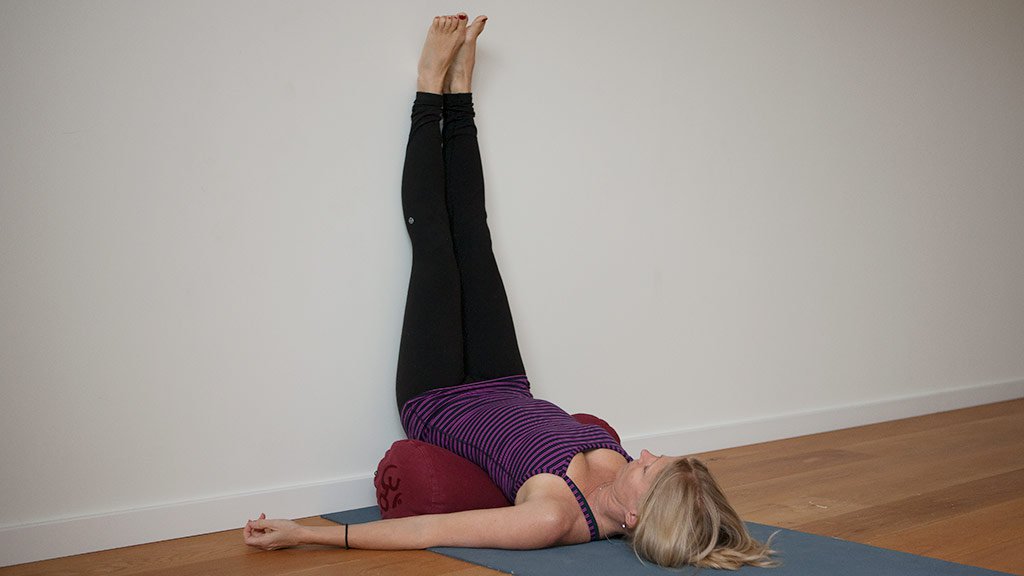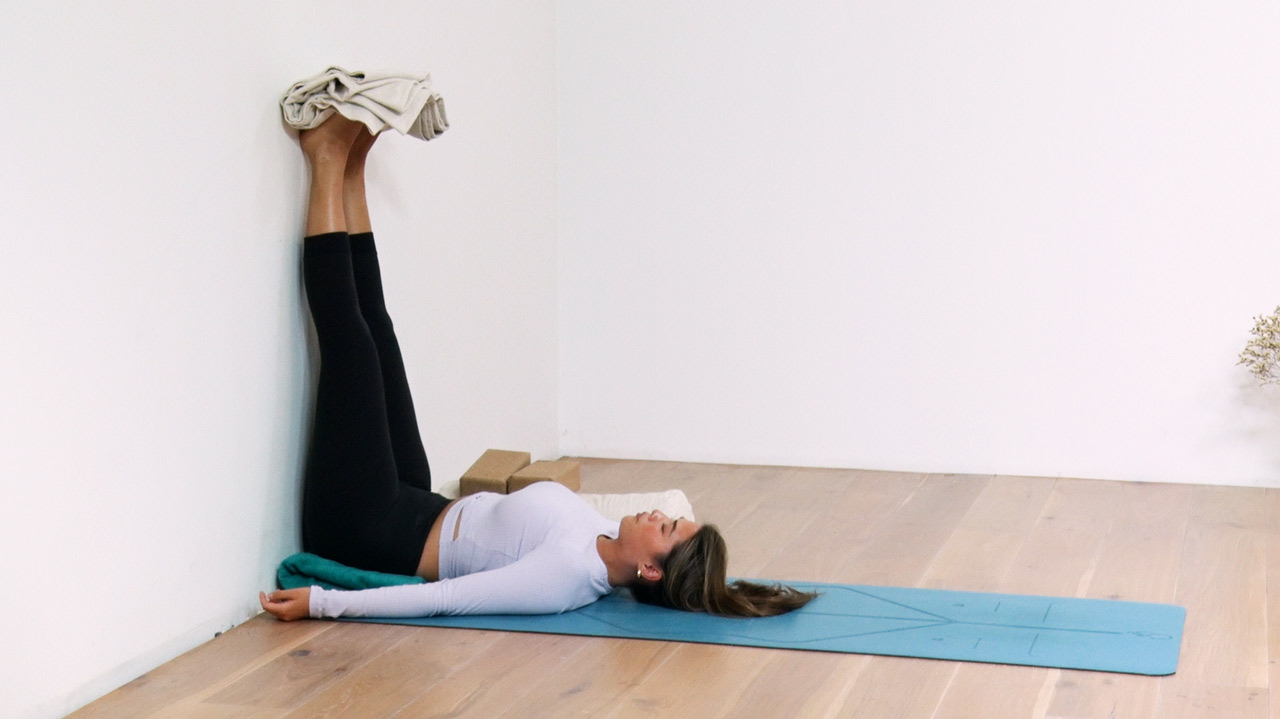It seems hard to believe that simply lying with your legs up the wall could make any difference to mental or physical health. But as yogis have known for thousands of years, it’s often the simplest postures that have the most profound effects. From calming the nervous system to strengthening immune health, giving some much-needed time out, and even promoting longevity, this ancient posture has so much to offer, especially in a world wrought with stress and busy-ness. For your how-to guide on Viparita Karani and its many benefits, read on!
Found within yogic texts as far back as the 17th Century, Viparita Karani’s name tells us a lot about the intention of the posture. From the word viparita meaning ‘reversed’ and karani meaning ‘in action’, ‘legs up the wall pose’ is intended to reverse and rebalance fluids, blood flow and energy. This posture doesn’t just aid reversing the flow of physical fluid but the also the flow of prana or ‘life force energy’. It’s because of this, Viparita Karani is considered to be a mudra as well as a yoga posture.
Mudras are symbols or gestures used to direct and enhance energy in the subtle body, and in this case, Viparita Karani is all about helping maintain healthy life force or subtle energy for as long as possible. In yogic texts such as the Hatha Yoga Pradipika, Viparita Karani is said to help rebalance energy that flows through the various nadis (energy channels) and chakras (concentrated ‘wheels’ of energy located along the spine), and even says that:
“After six months of practice, grey hairs and wrinkles become inconspicuous. One who practices it for three hours conquers death.”
Hatha Yoga Pradipika
Now, whilst we can’t make any promises regarding immortality or the prevention of grey hairs, the benefits of this posture could indeed aid in reducing oxidative stress. Thus meaning it could help reduce inflammation and just maybe reduce those grey hairs!
3 benefits of legs up the wall pose
1. Supports your lymphatic and glymphatic systems and gives your immune system a boost
Just as inversions like headstand and shoulderstand bring fresh blood flow and oxygen to the brain and upper body, Viparita Karani allows fresh, oxygenated blood to flow to the upper extremities, as well as stimulating the flow of lymphatic fluid. The lymphatic system plays an important role in filtering and breaking down bacteria and other potentially harmful cells. However, the nodes that do most of the filtering are found on the neck, armpits, stomach and groin, which is why inverted postures like this are so vital for sending fluid there. The lymphatic system doesn’t have a ‘pump’ like the blood’s circulatory system does, which means it relies upon gravity and movement to help aid in its function.
Another important but largely unknown benefit of raising the legs whilst resting is the ability to stimulate the glymphatic system. This system is in charge of effectively ‘sweeping away’ the bacteria that the lymphatic system has filtered, so it serves as an important second step of ridding the body of unwanted pathogens. The trick to making it all work that much better? Relax. Both of these systems work much better when the body is in a relaxed state.
2. Helps activate the parasympathetic nervous system – our rest and digest state
Resting in an inverted position encourages breathing to slow, which in turn helps communicate to the vagus nerve that it’s safe to start fully relaxing. The vagus nerve is a long nerve that starts in the brain and wanders down through the body, connecting to areas such as the throat, heart, diaphragm, and ending in the gut. This nerve is always sensing what’s happening in the body and sending messages back up to the brain, which then influences how we feel.
Rushing around and breathing fast? The vagus nerve senses stress, so it communicates ‘stress!’ to the brain, and the brain encourages the release of cortisol – the stress hormone. Lying with your legs up the wall and breathing slowly? This nerve senses you’re in a calm state and sends that message back up to the brain, so that it can help you move out of the sympathetic nervous system (‘fight or flight’) and into a parasympathetic state (‘rest and digest’).
3. Relieves aching muscles and joints and swollen ankles and feet
After rushing around or sitting at a desk for prolonged periods of time, the joints and spinal column can become compressed and drained of fluid, leading to more aches and pains. Practicing a few minutes of Viparita Karani can help reduce pressure on the lower back, as well as relieving feelings of heaviness and fatigue in the feet, legs and hips. For those who suffer with swollen ankles and feet, this posture can be a great way to reduce the swelling and discomfort.
Who should adapt this pose?
Whilst Viparita Karani is a gentle and safe posture for most people, there are certain circumstances when it’s best to opt-out or use a different variation where you are not lying completely flat on your back. This includes if you’re pregnant, if you suffer from glaucoma, or untreated high blood pressure. If you’re unable to practice this posture, a restorative and supported Savasana with cushions and blankets supporting the body is another wonderful way to ease yourself into deep relaxation. To help stimulate the glymphatic system, you can gently raise your feet a little on a cushion or yoga blocks, which will still bring big benefits.
How to do Legs up the wall pose
If you have a 5 or 10 minute break in your work day, I’d highly recommend making Viparita Karani a part of it. Just as the posture reverses and rebalances aspects of the physical and energetic body, it’s also a great way to shift your state of mind and give yourself a much needed break, so you can return to your day feeling refreshed and calm. The Hatha Yoga Pradipika advises practicing in the morning daily at the same time, but it works equally well as a way to decompress and de-stress in the evening.
- To get started, place a yoga mat against the wall, so that the short edge of the mat is touching the wall.
- Set a time for anything from 5 to 20 minutes (start with just a couple of minutes if you have never practiced before).
- Sit on the mat side-on to the wall, then manoeuvre yourself to lie down so that your legs can stretch up the wall.
- Your legs should be comfortable here, so if you need to, shuffle either close to or further away from the wall to suit you.
- Focus on breathing slowly and calmly, moving your awareness from your feet to your head when you inhale, and from your head to feet when you exhale.
- To come out of the posture, hug your knees into your chest and roll to one side.
- After a few moments, gently move into a Child’s pose position, then slowly come up to sit.
Try this free class – Restorative Legs up the Wall
In this class, we’ll practice supported inversions up against the wall. Supported inversions are a great way to help rejuvenate tired (or restless) legs and aching feet and calm the nervous system.


